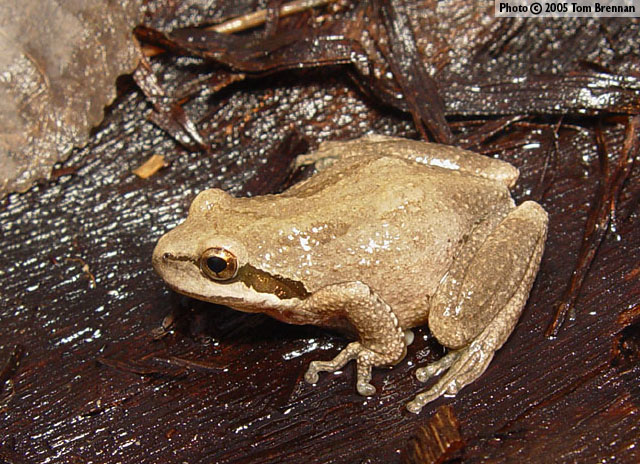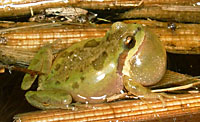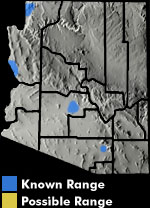Online Field Guide to The Reptiles and Amphibians of Arizona



Mohave County, AZ
 Mohave Co., AZ |
| BAJA CALIFORNIA TREEFROG Pseudacris hypochondriaca |
|
|
DESCRIPTION: To about 2 inches in length, this is a brown or green frog sometimes with dark spots or blotches. It is distinguished from other treefrogs in Arizona by a black or dark brown eyestripe that does not extend beyond the shoulder. Frogs can lose their spots and become lighter or darker with environmental conditions. Possesses prominent toe pads, and often has rougher skin than the similar Arizona treefrog. Tadpoles have eyes positioned not high on the head, are dark brown or black above, often with dark spots, and white with a coppery sheen below. The tadpoles attain a size of 1.8-2.2 inches prior to metamorphosis. DISTRIBUTION: No other treefrog occurs in the Baja California treefrog’s limited range in Arizona, which includes the lower Colorado River and adjacent wetlands and golf course ponds from Davis Dam to upper Lake Havasu, two or more livestock tanks in the Virgin Mountains, and plant nurseries in Apache Junction, Mesa, and Tucson. Populations in the Virgin Mountains and at the plant nurseries are introduced. The lower Colorado River populations may also be introduced, or could be native populations that were isolated from other Baja California treefrogs in southern Nevada by the creation of Lake Mohave. HABITAT: On the Colorado River, the Baja California treefrog occurs in backwaters and river edges grown over with cattails or bulrush. Most of these habitats are characterized by permanent water, but are often shallow and densely vegetated, which make them largely unsuitable for bullfrogs and other potential predators that abound on the Colorado River. Breeding also occurs at golf course ponds along the Colorado River, and at a Mesa Nursery, breeding was documented in the overflow pan of an evaporative cooler. The name “treefrog” is a misnomer – this species is typically found on the ground or in low shrubs. BEHAVIOR: Elsewhere within its range, non-breeding Baja California treefrogs often inhabit the uplands away from breeding ponds. Due to the arid nature of our uplands, such movements are probably limited in Arizona. Territorial males have an encounter call and will engage in wrestling and butting matches with opponents. REPRODUCTION AND CALLS: Breeding occurs from probably November into June in Arizona. Females typically lay 400-750 eggs per clutch in clusters of 9-80 usually deposited on submerged vegetation or sticks. A female may produce up to 3 clutches per year. Eggs hatch probably in 1-2 weeks and tadpoles take 2-3 months to metamorphose. The species’ distinctive “krek-ek” call is commonly heard in Hollywood movies. Extensive choruses of Baja California treefrogs can be heard after dark in the upper end of Lake Havasu. DIET: The diet of the Baja California tree frog includes isopods, spiders, snails, and a variety of insects. REMARKS: Introductions to plant nurseries likely occurred via treefrogs hitchhiking on ornamental plants imported from the Pacific coast. Recuero et al. (2006) propose to split the wide-ranging species, Pseudacris regilla, into three taxa. Arizona fits within the range of P. hypochondriaca as defined by those authors, but no frogs from Arizona were included in their analysis. Given that we may have both native and introduced populations, and the source(s) of the latter is unknown, the taxonomic status of Baja California treefrogs in Arizona is uncertain. By Jim Rorabaugh
Recuero, E., I. Martinez-Solano, G. Parra-Olea, and M. Barcia-Paris. 2006. Phylogeography of Pseudacris regilla (Anura:Hylidae) in western North America, with a proposal for a new taxonomic rearrangement. Molecular Phylogenetics and Evolution 39:293-304. Rorabaugh, J.C., J.M. Howland, and R.D. Babb. 2004. Distribution and habitat use of the Pacific treefrog (Pseudacris regilla) on the lower Colorado River and in Arizona. The Southwestern Naturalist 49(1):94-99. Rorabaugh, J.C., and M.J. Lannoo. 2005. Pseudacris regilla Baird and Girard, 1852(b), Pacific treefrog. Pages 478-484 in M.J. Lannoo (ed.), Amphibian Declines: The Conservation Status of United States Species. University of California Press, Berkeley, CA. |
|
Visit Partners in Amphibian and Reptile Conservation:


HOME
Copyright © 2023, Arizona Game and Fish Department. All rights reserved.
If you make use of the textual contents of this site in reports, publications, etc. please cite and credit the author(s) and photographer(s). All photos on this website are copyrighted. However, those found in the species account section may be used for any noncommercial scientific, educational, or conservation purposes provided that photographs are not altered and continue to bear the copyright symbol and name of the photographer. Please contact the photographer regarding commercial use of copyrighted photographs.










